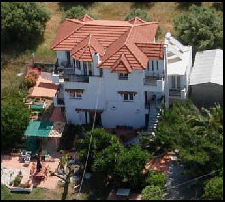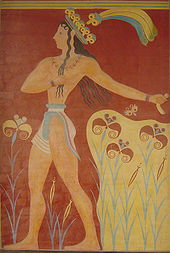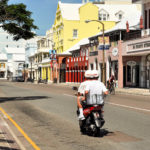A Gay Traveller on Crete, Greece: Traveler and writer Tim Mitchel sent this first hand report from Greece’s largest Mediterranean island.
By Tim Mitchell
Special report to GlobalGayz.com
June 2013
Say ‘Greece’ to most gay men and they will immediately say ‘Mykonos’, even if they haven’t been there. But of course Mykonos is not Greece any more than Greece consists only of Mykonos! Savvy gay travellers realised a long time ago that there are other islands to visit and many of them have discovered that Crete has more to offer than just the gay (often mixed) scene that you find on Mykonos. (Photo right: Heraklion city, capital of Crete)
About Crete
Best to start with a little more about Crete; the place, so diving straight in with a few statistics. Crete is the largest Greek island (and the fifth largest island in the Mediterranean; map left), it’s a long narrow island over 150 miles long, but less than 50 miles wide at the widest point, and has an area of some 3,000 square miles, compare this to Mykonos which has an area of around 30 square miles and already you can see that we are dealing with more than just a few beaches!
To put this in perspective, the US state of Delaware is about 2,500 square miles and has a population of just under a million. Crete on the other hand has a population of over 600,000, a lot of goats, and several million olive trees.
Each year the island of Crete welcomes over 2,000,000 visitors and travelling around the island in high season it is easy to see that Crete has its share of the ‘six percent’, and with a population that size there is guaranteed to be quite a resident gay population too. Some of these are not actually Greek but foreigners, like me, who have made their home here. Mykonos has around 1,000,000 visitors each year, not all gay, and a population of about 9,000.
For visitors of all kinds Crete has much to offer, some stunning scenery in the shape of rugged mountains, green and fertile plains and plateaus, small hill villages where you will still see people in traditional clothing which is their everyday wear, numerous idyllic beaches, some of the freshest food you will find anywhere in the World, (the salad we eat at night was likely growing in the ground that morning), and quite a lot of wine. In fact visitors from France, where they seem to know a bit about wine, often discard clothing and fill their baggage with Cretan wine to take back to France.
Exploring the island is not a ‘one day out’ experience, I have lived here for 9 nine years and there are still places that I have not visited. I know that 150 miles by 50 miles doesn’t sound very big, but bear in mind that many roads are full of hairpin bends and sometimes steep hills, with a few goats thrown in for good measure, and a visitor soon finds out why we are never in a hurry here to get anywhere. Even the road signage can be a point of interest with some place name signs full of bullet-holes, and spellings that differ both in the Latin character version and the Greek.
So what about the gay scene?
Of course there is a gay scene, and like all of Greece it is discreet, but that doesn’t mean we are all in the closet. Like any other country, a native or visitor must respect the religious and moral views on Crete, which is also renowned for hospitality. Few are actually interested in others’ sexuality. Locals mostly want to know where you come from, what you do for a living, are you married, do you rent or own you home, how much did you pay for it, or how much rent you pay, how much you earn (I have been asked that!), and even where your family originally came from. In a country where family ties are strong and family history is important, if you can say that you can trace your family back 500 years they will be really interested.
 For the busiest LGBT nightlife head to the area east of Heraklion to Hersonissos and Malia. These are probably the most cosmopolitan (and noisiest–very popular with vacationing hetero students) areas on the island and is home to the newly opened (2012) gay bar Roze Maandag close to the Beach Road in the centre of Hersonissos.
For the busiest LGBT nightlife head to the area east of Heraklion to Hersonissos and Malia. These are probably the most cosmopolitan (and noisiest–very popular with vacationing hetero students) areas on the island and is home to the newly opened (2012) gay bar Roze Maandag close to the Beach Road in the centre of Hersonissos.
If you find the busiest areas a bit naff (inferior and lacking style), as many visitors do, then head up the hill to the nearby villages of Pano Hersonissos and Koutouloufari where you will find some very gay friendly restaurants and also Vinnie’s Garden where they serve arguably the best mojito ( a traditional Cuban cocktail) In Greece!
Hersonissos also has one of the best known nudist beaches on the island (photo left) , it is not specifically gay, but most days it is only men, and is an excellent place to meet other travellers and indeed, a few locals. Around the island many of the beaches such as Kalives, Kommos, Agia Fotia, Vai, and Georgioupouis also have nudist sections and some discreet cruising too.
Also near Hersonissos is a gay guesthouse, Villa Ralfa (photo right), which has been running since 2004, and a new addition last year, a gay run hotel at Anisarras, called Home Hotel, where, depending on the clientele that week, they run pool parties and BBQ’s for the local and visiting gay population.
 All around Crete there is a wide range of accommodation from ‘5 star’ resort hotels with gyms, beauty salons, health spas, and restaurants serving Tex Mex food, to locally owned, family run, apartment blocks often with as few as 10 apartments. To experience true Cretan hospitality you really need to stay in the smaller places usually with less than about 25 rooms, the larger ‘all- inclusive’ places can be very comfortable (and expensive), but they are also rather ‘anonymous’, and some of them have a policy of not allowing same sex couples to have a room with a double bed!
All around Crete there is a wide range of accommodation from ‘5 star’ resort hotels with gyms, beauty salons, health spas, and restaurants serving Tex Mex food, to locally owned, family run, apartment blocks often with as few as 10 apartments. To experience true Cretan hospitality you really need to stay in the smaller places usually with less than about 25 rooms, the larger ‘all- inclusive’ places can be very comfortable (and expensive), but they are also rather ‘anonymous’, and some of them have a policy of not allowing same sex couples to have a room with a double bed!
Yes, it is wrong but that’s their policy and it is not going to change overnight. But you will not see much of Crete from the inside of a resort hotel no matter how many stars, or Tex Mex restaurants it has.
Smaller apartments/hotels have been letting rooms to people of the same sex since the package tour industry started, mainly because it is not unusual for 4, 5, or even 6 guys (or girls) to be holidaying together and invariably to fit this number of people into one apartment means that two of them will have to share a double bed!
I suggest you book direct with the hotel and ask for an apartment because this will more than likely have a bedroom with a double bed for the parents and ‘sofa beds’ in the lounge for the children. (If you haven’t got any children, you do have a double bed!) There is a LGBT website for home exchange: Home Around the World as well as a LGBT accommodations site: Purple Roofs. Also see GlobalGayz accommodations page.
As an added plus, although many of these are Greek owned, you quite often find the owner’s wife is not Greek and from a country that is more used to gay people than the Greeks are. And such is Cretan hospitality that if you stay in the same place two years in a row you almost become part of the family.
A Quiet Place Away From It All
 If you are looking for a quiet place ‘away from it all’ holiday”, I suggest you head to the south coast of Crete, the far south west, of the far east of the island. These areas tend to be less crowded as they are further from the airport, it means a three/four hour transfer time but when you get there you will find not only a warm welcome, but some fine less crowded beaches, and very good walks (something you will not find on Mykonos!).
If you are looking for a quiet place ‘away from it all’ holiday”, I suggest you head to the south coast of Crete, the far south west, of the far east of the island. These areas tend to be less crowded as they are further from the airport, it means a three/four hour transfer time but when you get there you will find not only a warm welcome, but some fine less crowded beaches, and very good walks (something you will not find on Mykonos!).
Pick any place on a map of Crete that is a long way from the airport and Google for hotels there. Most of them don’t even have web sites. Or even anything like an on line booking system, booking seems haphazard and they will ask for money in advance to make sure you turn up.
If this worries you a little then book somewhere close to the airport for the first couple of nights and then make a couple of phone calls when you get here to check if they have space, then jump into the rental car and head off into the wild blue yonder. Or just head off with no idea where you are going at all!
Archaeology of Crete
Crete was home to the Minoan civilisation which flourished from approximately the 27th century BC to the 15th century BC (that’s 1200 years!) and spread to neighboring islands. The most important site on the island is the vast Knossos ruins with it’s much publicized palace (photo below left). For unknown reasons (conquest? earthquake? volcanic explosion?) it was abandoned about 3000 years ago, between 1380–1100 BC. Minoan civilization was succeeded by the much larger Mycenaean civilization that arrived from the northern mainland of Greece.
(To put that into perspective, Machu Picchu in Peru was built about 550 years ago). There is much discussion about the pros and cons of the findings of the archaeologist, Arthur Evans, who excavated Knossos, but that’s another story. (https://en.wikipedia.org/wiki/Knossos)
 (Photos right: painted fresco of a male figure in the palace of Knossos, one of many beautiful frescos in the site. Four palace ruins have been found on Crete.)
(Photos right: painted fresco of a male figure in the palace of Knossos, one of many beautiful frescos in the site. Four palace ruins have been found on Crete.)
The mythological Olympian God, Zeus was alleged born on Crete and there is some discussion about exactly which cave he was born in, but that is also another story. (http://en.wikipedia.org/wiki/Zeus) For more mythology involving Crete you can read the novels Mary Renault which detail the legend of Theseus and the Minotaur; older unedited editions were controversial at the time of publication since they made reference to men falling in love with men.
For the amateur archaeologist and historian, there are many sites around the island worth visiting. In addition to Greek legends, Crete was occupied by the Romans (Hersonissos (photo left) was a Roman settlement and here and there the Roman remains can be seen sticking out from under 1960’s concrete buildings), the Venetians, and the Turks. All of whom have left their mark on the island in terms of architecture and language. There are small museums scattered around the island., including some dedicated to the events of the Second World War, Some of these also deal with Maritime history and one is dedicated to Nikos Kazantzakis, the author of ‘Zorba The Greek’.
the Venetians, and the Turks. All of whom have left their mark on the island in terms of architecture and language. There are small museums scattered around the island., including some dedicated to the events of the Second World War, Some of these also deal with Maritime history and one is dedicated to Nikos Kazantzakis, the author of ‘Zorba The Greek’.
Naturally many visitors to Crete are from northern Europe, Russia, and the Balkan countries, but these days many are long haul visitors from Australia, South America, New Zealand, the US, and even New Caledonia, who are island hopping using the ferry network to get around the Aegean Islands and include Crete on their itinerary along with Mykonos and Santorini. Many of these discover that Crete needs more than just a couple of days, so they change their plans and stay longer on Crete than any other island. Indeed some who have no set travel plans spend all their time on Crete and don’t bother going any further.
Like most Greek islands the main tourist season runs from April to October, but Crete with its larger population, is also ‘open’ during the winter and this is a good time to visit with the locals and see the island with its winter mantle of green and see how the olives are picked–although you will not be able to swim as the weather is often cold and wet.
















